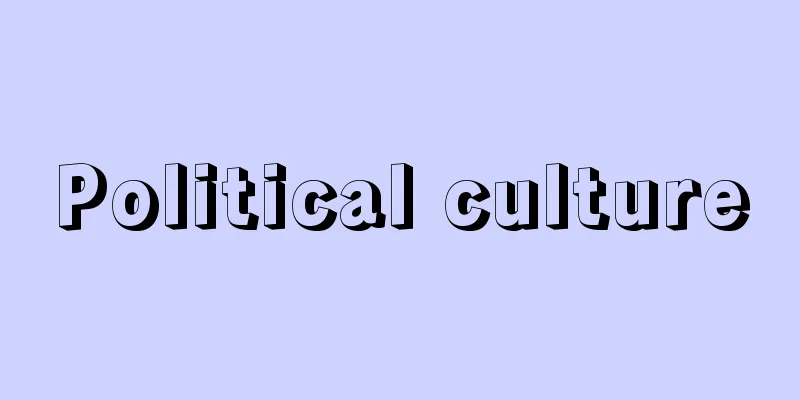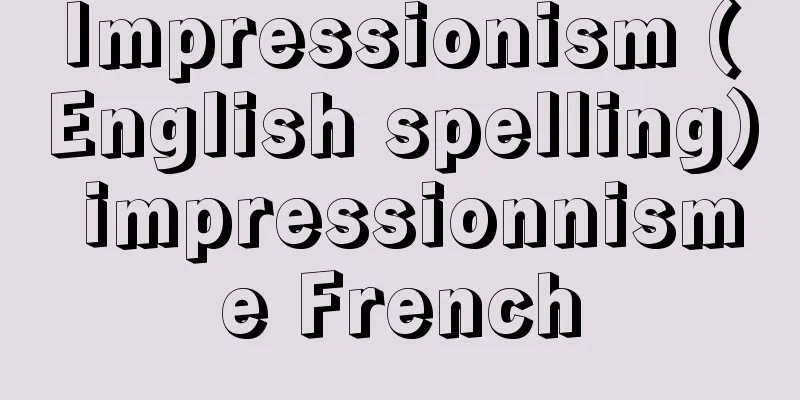Political culture

|
Political culture refers to the psychological orientation, such as cognition, emotion, and evaluation, toward political objects that exist among the people who make up a particular society. More specifically, the political culture of a society can be said to consist of a collection of attitudes, beliefs, and emotions that bring order and meaning to the political process and serve as the source of the basic assumptions and rules that govern behavior within the political society. [Yoshifumi Tanito July 19, 2016] Contemporary Politics and Political CultureTraditionally, political science has dealt with issues of culture in politics using concepts such as national character, political climate, political temperament, and ethnic ethos. However, after World War II, American political scientist Gabriel Abraham Almond (1911-2002), who was involved in comparative political research, introduced the concept of political culture as a universal key concept for comparing, analyzing, and understanding the differences and similarities between countries' politics both horizontally and vertically, and this concept has come to be used widely in modern political science. Almond categorizes political cultures into three basic types based on psychological orientations toward political objects such as political parties, political elites, power structures such as the executive branch, and the state. The first type is when there is no interest in political objects and there are almost no orientations toward cognition, emotion, evaluation, etc.; this type is called the undifferentiated type, and traditional political systems such as African tribal societies correspond to this culture. The second type is when people are interested in power structures such as the executive branch and the policy implementation process and have an orientation toward them, but do not have an orientation toward viewing themselves as subjects of political participation; this type is called the subject type, and centralized authoritarian political systems such as absolute monarchies correspond to this culture. The third type is when people recognize various political objects, feel both positive and negative feelings, and make some kind of evaluation, while also having an orientation toward viewing themselves as subjects of politics; this type is called the participatory type, and democratic political systems correspond to this culture. He also presented more realistic hybrid political cultures that combine the characteristics of these three basic political cultures, such as the undifferentiated-subject type (seen in the transitional period from feudal society to absolute monarchy), the subject-participatory type (seen in Germany and Italy from the 19th to 20th centuries), and the undifferentiated-participatory type (seen in modern developing countries). Furthermore, he argued that a loyal, participatory hybrid culture that is based on a participatory culture and moderately blends in an undifferentiated-subject culture is the most effective in maintaining a democratic political system, and he called it civic culture. [Yoshifumi Tanito July 19, 2016] Japanese Political CultureVarious views have been presented regarding Japanese political culture, including the "culture of shame" (R. Benedict), the "octopus trap culture" (Maruyama Masao), the "vertical society" (Nakane Chie, 1926-2021), and the "culture of conformity and competition" (Ishida Takeshi, 1923-2021), but what they all commonly point out is the existence of collectivism, closed-mindedness, centralism, and hierarchicalism in Japanese society. [Yoshifumi Tanito July 19, 2016] "Japanese Political Culture" by Ishida Takeshi (1970, University of Tokyo Press, UP Sensho)" ▽ "The Political Culture of Modern Citizens" by G. Almond and S. Verba, translated by Ishikawa Kazuo et al. (1974, Keiso Shobo)" ▽ "Japanese Thought" by Maruyama Masao (Iwanami Shinsho)" ▽ "Human Relationships in a Vertical Society" by Nakane Chie (Kodansha Gendai Shinsho)" ▽ "The Definitive Translation of The Chrysanthemum and the Sword by Ruth Benedict, translated by Hasegawa Matsuji (Shakai Shisosha, Gendai Kyoyo Bunko)" [References] | | |Source: Shogakukan Encyclopedia Nipponica About Encyclopedia Nipponica Information | Legend |
|
特定の社会を構成する人々の間に存在する政治的対象に対する認知、感情、評価などの心理的指向を政治文化と称している。具体的にいえば、ある社会の政治文化は、政治過程に秩序や意味をもたらし、政治社会内部の諸行動を規定する基本的な前提やルールの源となるような態度、信念、感情の集合から成り立っているといえよう。 [谷藤悦史 2016年7月19日] 現代政治学と政治文化従来、政治学においては、国民性、政治風土、政治気質、民族的エートスなどの概念を用いて政治における文化の問題を扱ってきたが、第二次世界大戦後、比較政治研究に携わってきたアメリカの政治学者アーモンドGabriel Abraham Almond(1911―2002)などが、各国の政治の相違点や類似点を横断的・縦断的に比較し、分析し、理解するための普遍的な鍵(かぎ)概念として、政治文化の概念を導入し、現代政治学において広く用いられるようになった。 アーモンドは、政党、政治エリート、行政府などの権力機構、国家などの政治的対象に対する心理的指向に基づき、政治文化を三つの基本的タイプに類型した。第一は、政治的対象に関心がなく、認知、感情、評価などの指向がほとんど存在しない場合で、未分化型と称し、アフリカの部族社会のような伝統的な政治体制がこの文化に対応している。第二は、行政府などの権力機構や政策の執行過程に関心を抱き、それらに対する指向をもっているが、自己を政治参加の主体としてとらえる指向が存在しない場合で、臣民型と称し、絶対王政などの集権的権威主義的政治体制がこの文化に対応する。第三は、さまざまな政治的対象を認知し、好悪両様の感情を抱き、なんらかの評価を下す一方、自己を政治の主体としてとらえる指向が存在する場合で、参加型と称し、民主的政治体制がこの文化に対応する。彼は、このほかに、これら三つの基本的な政治文化の特質をあわせもつより現実的な混合型の政治文化、未分化‐臣民型(封建社会から絶対王政への移行期にみられる)、臣民‐参加型(19世紀から20世紀にかけてのドイツ、イタリアにみられる)、未分化‐参加型(現代の開発途上国にみられる)などを提示した。さらに、彼は、参加型の文化を基礎にして未分化‐臣民型の文化を適度に融合した忠誠心のある参加型の混合文化が民主的政治システムを維持するうえでもっとも有効であるとし、それを市民文化と称した。 [谷藤悦史 2016年7月19日] 日本の政治文化日本の政治文化については、「恥の文化」(R・ベネディクト)、「タコ壺(つぼ)文化」(丸山真男(まさお))、「タテ社会」(中根千枝(ちえ)、1926―2021)、「同調‐競争の文化」(石田雄(たけし)、1923―2021)などさまざまな見解が提示されているが、それらが共通に指摘するのは、日本社会における集団主義、閉鎖主義、中央集権主義、序列主義などの存在である。 [谷藤悦史 2016年7月19日] 『石田雄著『日本の政治文化』(1970・東京大学出版会・UP選書)』▽『G・アーモンド、S・ヴァーバ著、石川一雄他訳『現代市民の政治文化』(1974・勁草書房)』▽『丸山真男著『日本の思想』(岩波新書)』▽『中根千枝著『タテ社会の人間関係』(講談社現代新書)』▽『ルース・ベネディクト著、長谷川松治訳『定訳 菊と刀』(社会思想社・現代教養文庫)』 [参照項目] | | |出典 小学館 日本大百科全書(ニッポニカ)日本大百科全書(ニッポニカ)について 情報 | 凡例 |
Recommend
Meng Jiangnu - Moukyou
A woman who appears in ancient Chinese tales. Whe...
merchant's ring
...Later, when the king sent his representatives,...
Genkei Nakane
Year of death: September 2, 1733 (October 9, 1733)...
Orchestra - Kangengaku
A relatively large ensemble that comes together t...
Palace
〘 noun 〙 (palace) ① palace. Royal palace. ※Amerika...
Tsugaru Mountains - Tsugarusanchi
A mountain range in western Aomori Prefecture tha...
Bow and harp
A type of koto. See the entry for "bow" ...
Memorial service for a thousand monks - Sensoukuyo
It is also read as "Senzoukuyo". It is ...
Publius Terentius Afer
A Roman comic playwright. A Libyan born in Cartha...
Mizuhiki - Mizuhiki
〘Noun〙① The act of soaking hemp etc. in water and ...
Ikenozenni - Ikenozenni
Dates of birth and death unknown. A woman from th...
Pithecellobium dulce (English spelling) Pithecellobium dulce
...Many of the Parkia species (such as Parkia rox...
Traveling Mountain People - Traveling Mountain People
…His first name was Yan. His pen name was Ganbo, ...
Kaida Plateau
(Kiso Town, Kiso District, Nagano Prefecture) A to...
Damasus I
…He was greatly inspired by the lectures of Apoll...









